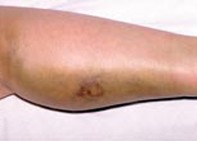Peer Reviewed
Feature Article Cardiovascular medicine
Managing the patient with venous thromboembolic disease
Abstract
The mainstay of management of deep vein thrombosis and pulmonary embolism continues to be anticoagulation with heparin acutely followed by warfarin in the longer term. Several novel agents are at various stages of development but none yet has been shown to be as safe and effective as warfarin.
Key Points
- Above knee deep vein thrombosis (DVT) and pulmonary embolism (PE) are increasingly being managed in the ambulatory setting with low molecular weight heparin (LMWH) followed by longer term warfarin therapy.
- LMWH or unfractionated heparin (UFH) should always be commenced prior to warfarin, and heparin should be continued for a minimum of five days, and until the INR has been at a therapeutic level for at least two days.
- An INR between 2.0 and 3.0 is recommended for DVT and PE treatment.
- Anticoagulant duration of at least three months for proximal DVT and PE are recommended, with a longer duration for idiopathic thrombosis and for patients with persisting risk factors, such as active cancer.
- Anticoagulation is also recommended for symptomatic below knee DVTs, but as the risk of serious complications is lower, a shorter duration of therapy is recommended. If the risk of bleeding is high, it is safe to withhold anticoagulation and repeat an ultrasound in seven to 10 days.
- Ultrasonography may help to predict the likelihood of thrombosis recurrence and assist in determining anticoagulant duration.
Purchase the PDF version of this article
Already a subscriber? Login here.

